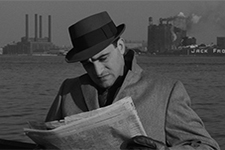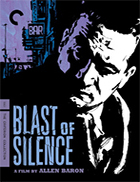Blast of Silence
|  For a no-budget film shot on location in New York City on the sly with a nonactor in the lead role, there is a grand, existential audacity to Allen Baron’s Blast of Silence. A particularly dour film noir made several years after the genre had been declared over in the wake of Orson Welles’s Touch of Evil (1958), Blast of Silence opens with birth and ends with death, turning its threadbare story about a Midwestern hitman going about his business in New York into a uniquely compelling treatise on the meaninglessness of it all. Of course, that is right up noir’s alley, with its dark tales of corruption, loss, and the irretrievable past, and Baron—a former comic book artist turned filmmaker—captures it and distills it to the essentials. On the one hand, Blast of Silence is simplicity personified. On the other, it is its own kind of perfection. Part of the film’s strange power derives from its narration, which is typical of many film noir and can be grating when done badly. The narration in Blast of Silence is compelling precisely because it is not in first person, but neither is it third person. Rather, it comes from the second person, constantly referring to “you” as if we the viewers are ontologically connected to the central character, which is a heavy burden given that he’s a professional killer with serious alienation issues. Written by blacklisted screenwriter Waldo Salt (under the pseudonym Mel Davenport), the narration is stark and poetic, especially as delivered by grizzled blacklisted actor Lionel Stander, who sells every line with hardened conviction that borders on the corrosive. The narration does a lot of heavy lifting in the film, which is often a weakness; but, as used by Barron, it is so effective in not only adding depth, but also suturing us into the narrative, that it is hard to view it as anything other than absolutely essential. Without the narration, the film would be an interesting story about a hitman. With it, it becomes an allegory for the dark heart we all possess. Baron cast himself as the central character, Frank Bono, only because Peter Falk, then a young, up-and-coming actor, dropped out at the last minute. What could have been a disaster turned out to be a stroke of luck because it turns out that Baron, despite being a relatively inexperienced actor, was perfectly suited for the role of a lonely killer. Frank is a man who isn’t comfortable anywhere, and Baron conveys that sense of disassociation quite powerfully. And, while some have suggested that this is because Baron simply didn’t feel entirely comfortable in front of the camera, the same cannot be said of his work behind it. A first-time feature director but a lifelong New Yorker, Baron had an innate sense of how to use New York City as a character, turning the urban environment into a crucial landscape within which Frank’s identity crisis can unfold. Much of the film was shot handheld and on the sly, which reinforces its sense of immediacy and location; no one would ever mistake it for something fabricated in even the best of studios. The story takes place over several days, beginning with Frank’s arrival at Penn Station, which Baron depicts as a kind of birth. His assignment is to assassinate “a second-string syndicate boss with too much ambition” named Troiano (Peter H. Clune). Frank dutifully stakes out his target, figuring out where he goes and when he will be most vulnerable. He also secures possession of a handgun and a silencer from a creepy, corpulent dealer named Big Ralph (Larry Tucker), whose pudgy, soft-spoken nature belies a much darker heart. If the film has a weak spot, it is Frank’s relationship with a fresh young thing named Lorrie (Molly McCarthy), who gives him the illusion that he could be something more than a hired killer. The idea is good, but something about their scenes feels forced and out of touch. Nevertheless, as a whole Blast of Silence is a striking little film—and I use the word little as a compliment. It is stark and streamlined at only 77 minutes, with not an ounce of fat on it. Baron draws from a well of sources both cinematic and literary, but the film feels very much its own. Unfortunately, it arrived a little too late in the film noir cycle, and as a result was stuck on the second half of a double bill headlined by, of all things, Elia Kazan’s Splendor in the Grass (1961). Baron went on to direct two more features, neither of which made much of a splash, and then several hundred television episodes throughout the 1970s and ’80s. Blast of Silence gained a cult following and has been resurrected over the years at film festivals, which has allowed audiences to marvel at this audacious and not-quite-forgotten gem that remains just as dark and moody as it was six decades ago.
Copyright © 2023 James Kendrick Thoughts? E-mail James Kendrick All images copyright © The Criterion Collection | |||||||||||||||||||||||||||||
Overall Rating: 


 (3.5)
(3.5)


